

|
|
|
|
\  |
| INTEGRATING DEVELOPMENT AROUND STATIONS | ||
| Transportation investment has historically generated multiplier investment in adjacent real estate property. With our existing transportation systems all over loaded, an elevated transportation network is needed for continued growth. Automated Guideway Transport (AGT) offers the potential to unclog existing systems and cause new growth of pedestrian villages around stations. For each AGT route thousands of development jobs will be created and these could grow into millions as the routes interconnect. | ||
Initial
Types of Stations
Click on these pictures to enlarge. See examples how stations
serve existing buildings, parking
lots and curbside. These are single bay
stations
|
Public Stations |
Private Stations Outside | Private Stations Inside |
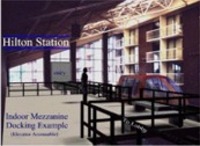 |
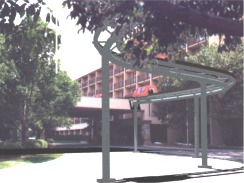 |
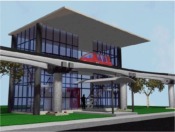 |
|
|
|
|
Typical Public Station |
Initial Infrastructure Model |
|
|
|
Pedestrian Villages
Since Skyways stations are above the ground level, this technology will grow transit oriented pedestrian concourses appealing to retailers, entertainment, advertisers and other travel venders. These are examples of how stations can be integrated into new pedestrian development and attract people to live on-line without owning a car by offering very convenient access to more options. For example in the 57 mile metro route people could get to75% of all the the happenings in Denver, malls, hospitals, campuses, office parks, amusements and recreation - all within a 2 block walk. Many of life's necessities could be in each little village and accessible with a short walk for common errands to the post office, bank, cleaners, grocery, hair salon, bar and restaurants. With metro rates of only $100 per month for unlimited use, people could be attracted to give up their car ownership and garages in exchange for this old fashioned pedestrian lifestyle.
Click on the picture to open the file.
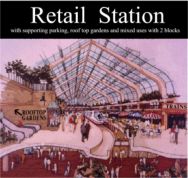 |
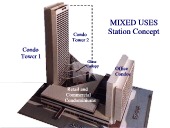 |
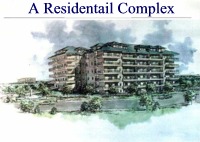 |
Future Pedestrian Villages
|
A typical station can serve mixed land uses within a 2 block radius (850') which encompasses 15 blocks averaging 100,000 square feet each. This represents 1.5 million square feet of buildable land around a station for density with a mix of uses including condos, hotel, retail, offices, restaurant and recreational.
Denver
Mixed Use Zoning |
Most of the benefits of a new walking pedestrianism are in losing the costs of modern things like: our weight, designer diets, expensive gym memberships. car ownership, insurance, repairs, parking, and gas. Improving our health would mean fewer doctor visits, tests, specialists and less medical insurance.
|
|
OPEN SPACE |
|
|
Station Parking-In order to attract riders, parking will need to be developed at many stations. This is usually a problem with developers because it often doesn't pay for itself and take up a lot of very expensive land. Over time, parking garages can be built on the outside of the village freeing the inside for a car free zone. These cars zones would interface with city street grids. Tax increment financing can be used to off set the cost factor. Because of increasing congestion and rising land values, automated parking is poised to become the next big trend in parking. |
 |
Station Rental Cars by The Hour
This European concept is based on the premise that households don’t need to own or long-term lease cars to maintain mobility. This is a mobility systems with several to many cars and subscribers. Subscribers reserve and use the cars for some or all of their trip-making needs. Each car is used multiple times per day by different subscribers. Thus the proportion of cars to subscriber households is smaller, as much as a factor of 10 smaller, than if every subscriber household had its own car. This means the amount of land dedicated to parking cars can be reduced substantially because there are many fewer cars to be parked. It requires a reservation and billing systems, fleet management systems, vehicle access systems, and other hardware and software. |
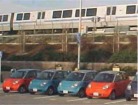 |
New Land Uses
|
At station stops there is a tremendous amount of development that can take place within one block walk as shown below in the graphic. This development will most normally support a mix of uses. The highest density is closest to the station and then into gradually diminishes down to single family homes. SmartSkyways is shown (in red) using the median of a major street like Colorado Blvd. From the station people can be distributed around the site using an at grade site circulator (yellow) that runs from the edge into the middle to the stations and parking. The site circulator also can link the multi family areas allowing for a car free environment around the stations. |
|
|
|
Intermodal Stations
|
The Platte Valley Intermodal at DUT
|
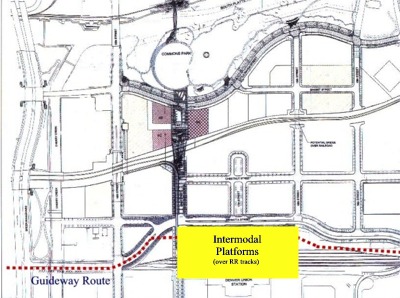 |
RTD is illustrating the plan below for a second level platform over a rail station
|
|
|
Skyways can fit into the DUT Intermodal by docking above the platform behind DUT Such a platform can be part of the costs of the local route. It could also generate revenues from other venders such as ticket offices and pre-boarding gates for the airport. Retail could be included.
|
Future Intermodal
| This is an illustration of a very futuristic
cargo Intermodal using Hoover Craft, Helicopters, Trucks, trains and automatic Handling.  |
Economic Impacts and Consequences (Coming Soon)
Land Uses: clustered & mixed: housing, retail, office, hotel, parking, entertainment, recreation
Growth: density clusters as an alternative for 50% of new growth instead of sprawl
Taxation: district and private instead of government and general taxation
Open Space: high density vertical spaces at stations vs existing low density parks
Stations: Intermodals at DIA, DUT and DTC
|
Summary | Corporate | Technology | Routes | Market | Interact | Search |
||
|
Alternative Transit | Personal Rapid Transit (PRT) | People Movers |
||
|
Copyright © SmartSkyways, LLC. 2006. ALL RIGHTS RESERVED |